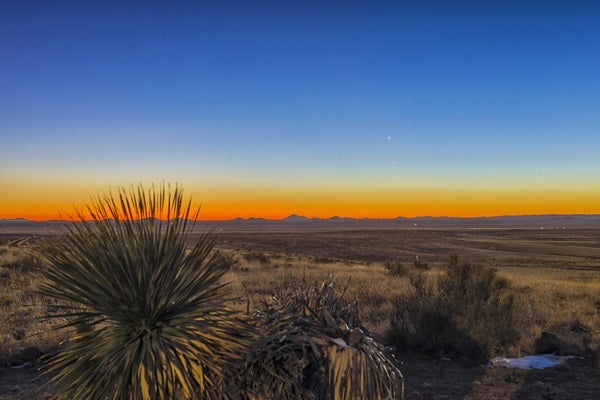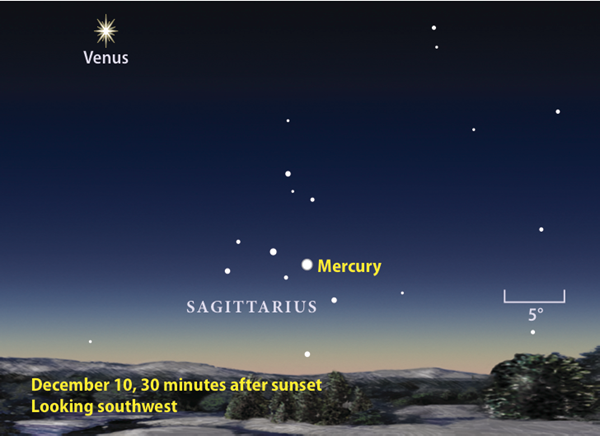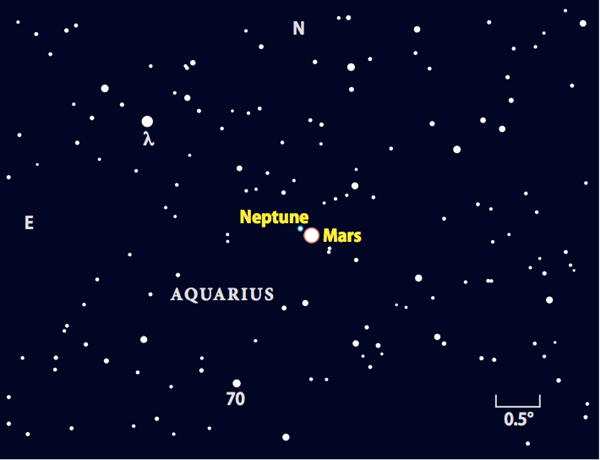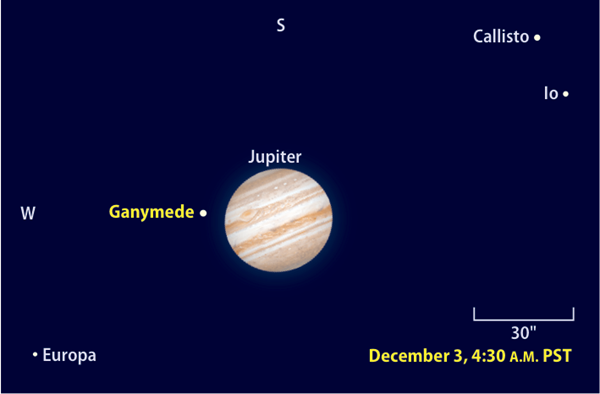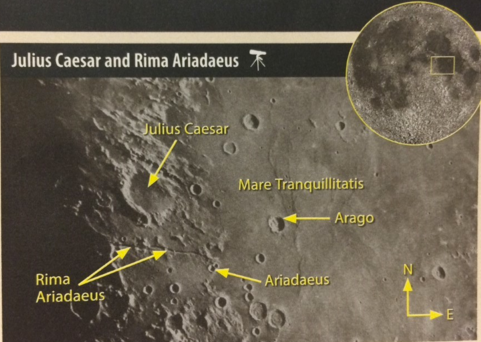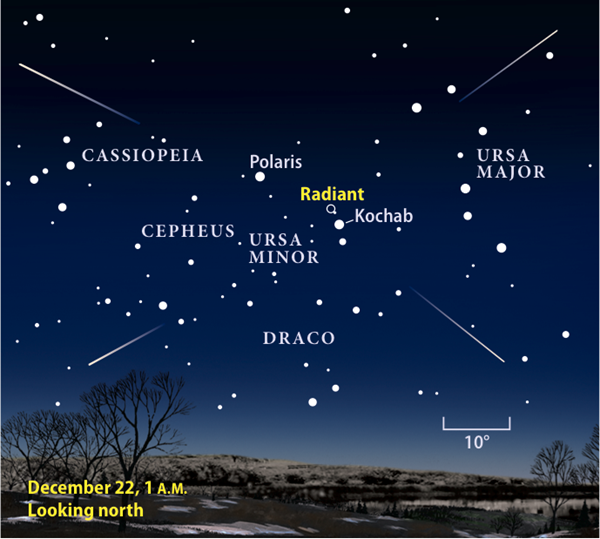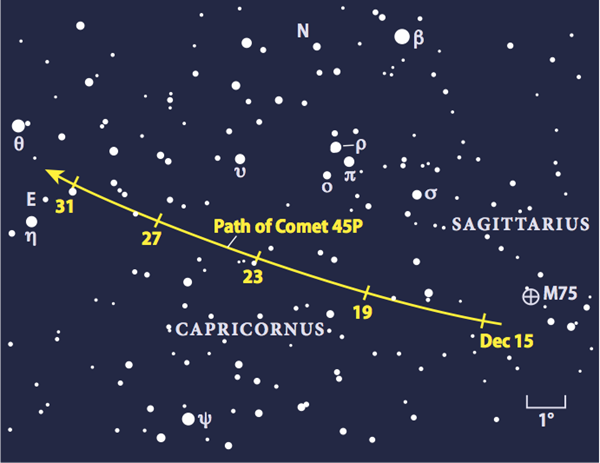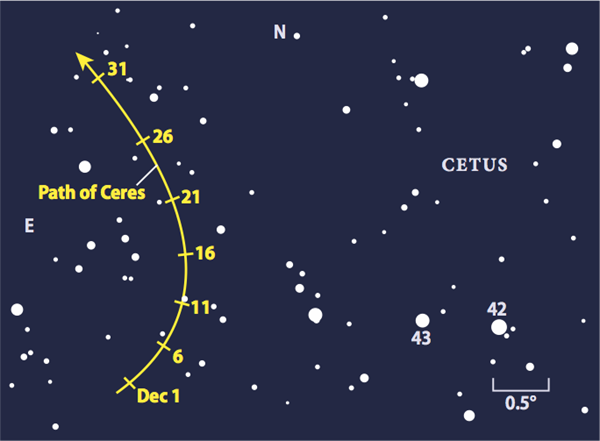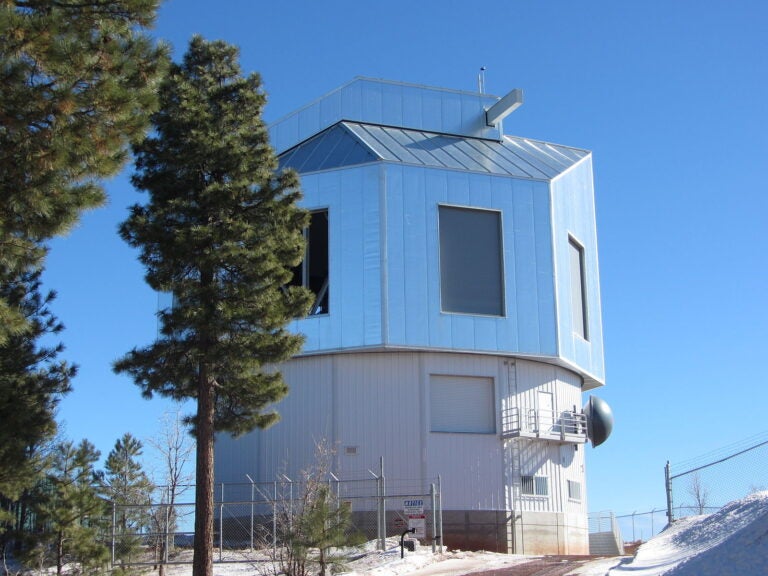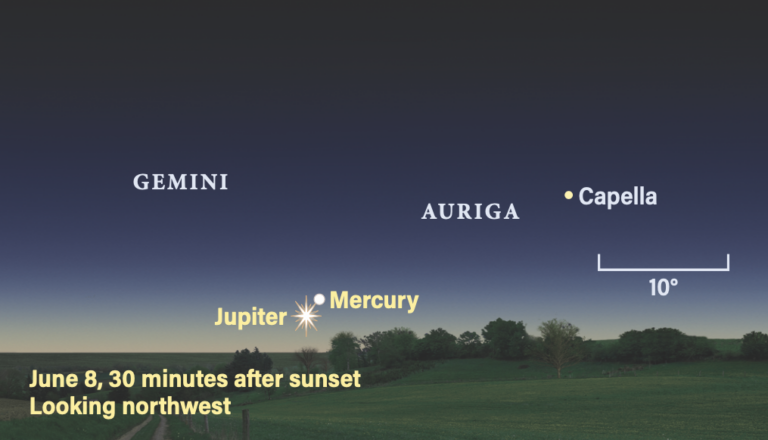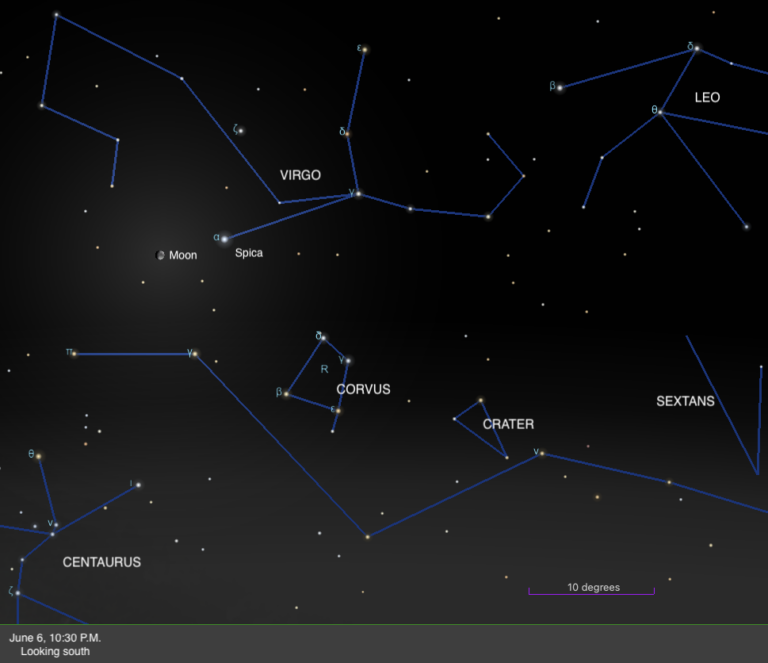Three bright planets adorn December’s evening sky. Mercury, Venus, and Mars line up above the southwestern horizon, changing positions relative to one another night by night. As a bonus, the Red Planet passes breathtakingly close to Neptune on New Year’s Eve. The morning sky appears more subdued, with brilliant Jupiter the lone planet visible in a dark sky.
The action gets underway early on the evening of December 1. Thirty minutes after sunset, a two-day-old Moon stands 15° high in the southwest. If you drop two-thirds of the way to the horizon from there, you should see Mercury. The innermost planet shines at magnitude –0.5, bright enough to see against the twilight with the naked eye, though you may need binoculars to locate it initially. Point a telescope at Mercury and you’ll see a 5.6″-diameter disk that is 82 percent lit.
With each passing day, the inner world becomes a bit easier to see as it climbs into a darker sky. At greatest elongation on December 10, Mercury lies 21° east of the Sun and appears 7° high a half-hour after sunset. A telescope reveals a disk that spans 6.6″ with sunlight illuminating 63 percent of it.
Although the planet starts to dim after greatest elongation, it maintains its altitude for another week. The view through a telescope also improves. On the 17th, magnitude 0.0 Mercury shows a disk that measures 8.0″ across and is just one-third lit.
The Moon pointed the way to Mercury on December 1, and it performs a similar service for the other evening planets in the days after. The waxing crescent lies 8° to Venus’ right on the 2nd and a similar distance above the planet the following night. By December 4, the Moon moves to a point 6° to Mars’ right.
Truth be told, however, you won’t need the Moon’s help to find Venus. The planet shines brilliantly at magnitude –4.2 in early December and brightens to magnitude –4.4 by month’s close. No other object comes close except when the Moon shares the sky.
Venus also gains considerable altitude during December. The planet appears some 15° high in the southwest an hour after sunset early in the month. By New Year’s Eve, it stands 25° high and sets nearly four hours after the Sun. The greater altitude means that a telescope will deliver sharper views. On the 31st, Venus shows a disk 22″ across and 57 percent lit.
The inner planet calls three different constellations home this month. It spends December’s first week in eastern Sagittarius, passing 0.8° south of 9th-magnitude globular star cluster M75 on the 6th. It crosses into Capricornus the following day and then makes a beeline through the heart of the Sea Goat. The planet slides 1° north of this constellation’s brightest star, magnitude 2.8 Delta (δ) Capricorni, on the 28th. The final day of 2016 sees Venus slip across the next constellation boundary into Aquarius.
The planet’s rapid motion makes it appear as if it is chasing Mars. The two planets stand 23° apart on the 1st; the gap shrinks to 12° by the 31st. At magnitude 0.8 in mid-December, Mars glows 100 times more dimly than Venus. Still, the Red Planet appears conspicuous because of its greater altitude and distinctive color.
Mars begins the month in central Capricornus. Its eastward journey carries it 1.5° north of Delta Cap on December 11, and it crosses into Aquarius on the 15th. The planet reaches the middle of this constellation by New Year’s Eve, when it has a spectacular reunion with Neptune. It’s the closest conjunction between these two planets in more than 700 year.
For observers in North America, the two planets stand 9.8′ apart from the East Coast and just 4.4′ apart from the West Coast an hour before they set. Those in Hawaii see closest approach, when Mars skims 1.3′ north of Neptune. The view through a telescope will be spectacular. Neptune looks like an 8th-magnitude satellite of Mars, with the icy blue-gray hue of the distant world providing a striking contrast to the warm, ruddy glow of Earth’s neighbor. Mars spans 5.7″ on the 31st, some 21/2 times bigger than Neptune’s 2.2″-diameter disk.
One constellation east of Aquarius lies Pisces the Fish, the home of Uranus. The region stands high in the southeast after nightfall and climbs nearly two-thirds of the way to the zenith in the southern sky an hour or two later. Although the planet shines at magnitude 5.8, bright enough to see with the naked eye from a dark-sky site, binoculars make it much easier to spot.
To track it down, first locate 5th-magnitude Zeta (ζ) Piscium. This nice double star lies 17° east-southeast of magnitude 2.8 Algenib (Gamma [γ] Pegasi), the star at the southeastern corner of the Great Square of Pegasus. Uranus lies less than 1° east of Zeta throughout December. The gap between the two closes from 52′ on the 1st to 35′ during the month’s final days. Don’t confuse Uranus with the magnitude 6.0 star 88 Piscium, which lies 38′ south-southeast of Zeta. A telescope can confirm a planet sighting by revealing its 3.6″-diameter, blue-green disk.
At about the time that Uranus dips below the western horizon, Jupiter rises in the east. There’s no mistaking the giant planet — at magnitude –1.8, it is the brightest point of light anywhere in the morning sky.
Jupiter moves slowly against the backdrop of central Virgo this month. On December 1, it stands 8° northwest of that constellation’s luminary, 1st-magnitude Spica. The planet’s eastward journey carries it to a point 4° north-northwest of the star by the 31st.
For the best views of Jupiter through a telescope, wait until it climbs some 30° above the southeastern horizon an hour or so before twilight begins. The giant planet offers a disk large enough (34″ across at midmonth) to deliver exquisite detail through even the smallest telescopes. Two broad, dark, atmospheric belts — one on either side of a brighter zone that coincides with the equator — show up easily. Under excellent observing conditions, a series of alternating belts and zones pops into view.
But not all of the action resides in Jupiter’s atmosphere. The planet boasts four large moons that change positions from night to night and sometimes within an hour or two. Each of the three inner moons typically appears east or west of Jupiter, but once each orbit, it will pass in front of (transit) the giant world. Shortly before a transit, the moon’s black shadow sweeps across the jovian cloud tops. Half an orbit later, the moon disappears behind the planet (an occultation). Only outermost Callisto avoids Jupiter entirely; you can find it due north of the planet’s disk around 3 a.m. EST on the 11th, for example.
A trio of satellite events occurs on December 14. Ganymede, the solar system’s largest moon, begins to transit Jupiter’s north polar region at 2:40 a.m. EST. Although only observers in eastern North America can witness the transit’s start, nearly everyone can see the conclusion at 5:08 a.m. Io’s shadow begins a transit just seven minutes later, at 5:15 a.m., followed by Io itself at 6:21 a.m.
December 17 finds Europa beginning to transit Jupiter at 3:56 a.m. EST, just 17 minutes before the same moon’s shadow leaves the planet’s disk on the opposite limb.
A nice set of events involving Ganymede takes place from western North America on December 3. Because Earth currently lies west of a line joining the Sun and Jupiter, we see the giant planet’s shadow extending to the west. Ganymede orbits far enough from its host that it can vanish into Jupiter’s shadow, briefly emerge into sunlight, and then disappear behind the planet’s disk. The moon comes out of shadow at 4:02 a.m. PST on the 3rd and remains in bright sunlight until it slips behind Jupiter’s disk at 5:24 a.m.
Saturn briefly appears in the morning sky at the end of December. On the 31st, the ringed world rises nearly 90 minutes before the Sun and climbs 6° above the southeastern horizon some 45 minutes before sunup. Saturn shines at magnitude 0.5, bright enough to see against the twilight through binoculars.
| WHEN TO VIEW THE PLANETS | ||
| Evening Sky | Midnight | Morning Sky |
| Mercury (southwest) | Uranus (west) | Jupiter (southeast) |
| Venus (southwest) | Saturn (southeast) | |
| Mars (south) | ||
| Uranus (southeast) | ||
| Neptune (south) | ||
At the edge of a tranquil sea
The gorgeous crescent Moons that adorn early December’s evening sky show an abundance of features through any telescope. The most striking details appear along the terminator, the line that divides day from night, when the low Sun casts long shadows that exaggerate the apparent height of features. Under a higher Sun, the topography seems to vanish. The north-south ridges crossing the plains of Mare Tranquillitatis stand out on December 4, when sunlight first touches the ramparts of the sharply defined crater Arago.
By the 5th, the illumination nearly matches that in the image at right. How did the forces of nature create this weird landscape? Scientists have pieced together the likely story. First, an asteroid slammed into the young Moon, carving out the huge Mare Tranquillitatis basin. Next, a smaller impactor scooped out the 55-mile-wide crater Julius Caesar. The crater formed on a slope, which left its eastern rim lower. Later still, lava welled up through cracks in the large basin next door. The rising lava breached Julius Caesar’s eastern wall and swallowed the central peak, too, but could not reach the higher western wall.
The long line south of Julius Caesar is Rima Ariadaeus, a collapsed valley a half-mile deep created when two zones pulled apart. The low Sun highlights the roughness of the terrain here. Ariadaeus Crater is the larger of the two overlapping craters just south of the valley’s eastern end. By the next evening (the 6th), the Sun reveals the equally impressive Rima Hyginus to the west, though Rima Ariadaeus has started to disappear.
Will the Bear best the Twins?
December typically features two fine annual meteor showers: the prolific Geminids and the minor Ursids. Unfortunately, a bright Moon interferes with the Geminids this year. The shower peaks on the night of December 13/14, the same night as this month’s Full Moon. Scattered moonlight will drown out all but the brightest meteors. The “shooting stars” appear to radiate from Gemini the Twins, while the Full Moon lies one constellation to the west, in Orion. Although rates can reach 120 meteors per hour in good years, the Moon likely will reduce this by 90 percent.
You’ll probably have more success viewing the Ursids. This shower peaks on the night of December 21/22 under a waning crescent Moon, which rises just after 1 a.m. local time. The best views should come within an hour of midnight. The shower’s radiant lies near Kochab in the Little Dipper’s bowl, in the constellation Ursa Minor the Little Bear. Expect to see 10 meteors per hour under a dark sky.
The start of good comet viewing
The next eight months promise to be a comet-chaser’s paradise. Astronomers predict that as many as five comets could shine at 10th magnitude or brighter, and three of them should come within binocular range. The peak should come in February and March, but the exhibition begins in the second half of December.
Comet 45P/Honda-Mrkos-Pajdusakova arrives first. The Moon moves out of the evening sky on December 15, opening a dark-sky window for the rest of the month. You’ll need an open view to the southwest and have eye to eyepiece an hour after sunset. The comet lies about 15° above the horizon on the 15th.
A bonus that evening is the presence of the 9th-magnitude globular star cluster M75 just 1.5° to the west-northwest. You’ll actually see the globular first because it shines about a magnitude brighter than 45P. But the dirty snowball brightens at a wonderful rate and should crack 8th magnitude by month’s end.
The best aspect of viewing this comet will be its razor-sharp tail. On December 21, comet watchers get an edge-on view of its fan-shaped dust outflow. Based on previous visits of this periodic comet, astronomers expect it to show a round, blue-green head at the front of a gray-white spike. Imagers likely will capture the faint blue emissions from the tail’s ionized gas. Ten days later, on New Year’s Eve, astroimagers can catch a pretty crescent Moon posing just 3° from 45P.
Japanese astronomer Minoru Honda spotted the comet on December 3, 1948, and Antonin Mrkos and Ludmila Pajdusakova independently found it soon after. The comet returns to the inner solar system every 5.25 years, but we don’t always get a good view. Fortunately, this is one of its best appearances.
The largest object in the asteroid belt by far is the dwarf planet Ceres, which spans an impressive 600 miles and holds approximately one-third of the asteroid belt’s entire mass. Two years ago, astronomers knew precious little about this giant ball of rock and ice. But that changed dramatically starting in April 2015, when NASA’s Dawn spacecraft went into orbit. Each month brings new discoveries as planetary scientists analyze the latest observations. What better time could there be to track down this captivating world through binoculars or a telescope?
Fortunately, Ceres now climbs more than halfway to the zenith in the southern sky in early evening. Although it dims from magnitude 8.1 to 8.6 during December, it lies in a fairly sparse region of Cetus the Whale. To find it, first locate magnitude 3.6 Theta (θ) Ceti, located on the Whale’s back. Then head 8° north to the magnitude 5.6 star 42 Ceti, the brightest star on the chart below. Ceres lies about 3° east of this star during the first half of December before it starts moving northward at a significantly faster pace.
The dwarf planet shines about as brightly as any of the background stars in its immediate vicinity. The map shows stars down to magnitude 9.5, so you should be able to tell which object is out of place simply by comparing your eyepiece view with the chart. If you can’t tell which of the myriad points of light is Ceres, make a sketch of the area showing the relative positions of five or six stars. Return to the same field a couple of nights later to confirm which object moved — that one is Ceres.

